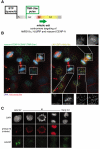Replicating centromeric chromatin: spatial and temporal control of CENP-A assembly
- PMID: 22561213
- PMCID: PMC3616609
- DOI: 10.1016/j.yexcr.2012.04.007
Replicating centromeric chromatin: spatial and temporal control of CENP-A assembly
Abstract
The centromere is the fundamental unit for insuring chromosome inheritance. This complex region has a distinct type of chromatin in which histone H3 is replaced by a structurally different homologue identified in humans as CENP-A. In metazoans, specific DNA sequences are neither required nor sufficient for centromere identity. Rather, an epigenetic mark comprised of CENP-A containing chromatin is thought to be the major determinant of centromere identity. In this view, CENP-A deposition and chromatin assembly are fundamental processes for the maintenance of centromeric identity across mitotic and meiotic divisions. Several lines of evidence support CENP-A deposition in metazoans occurring at only one time in the cell cycle. Such cell cycle-dependent loading of CENP-A is found in divergent species from human to fission yeast, albeit with differences in the cell cycle point at which CENP-A is assembled. Cell cycle dependent CENP-A deposition requires multiple assembly factors for its deposition and maintenance. This review discusses the regulation of new CENP-A deposition and its relevance to centromere identity and inheritance.
Copyright © 2012 Elsevier Inc. All rights reserved.
Figures


References
-
- Bell SP, Dutta A. DNA replication in eukaryotic cells. Annu Rev Biochem. 2002;71:333–374. - PubMed
Publication types
MeSH terms
Substances
Grants and funding
LinkOut - more resources
Full Text Sources

